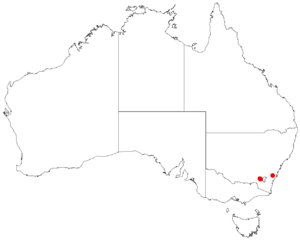Prostanthera makinsonii facts for kids
Quick facts for kids Prostanthera makinsonii |
|
|---|---|
| Scientific classification | |
| Genus: |
Prostanthera
|
| Species: |
makinsonii
|
 |
|
| Occurrence data from AVH | |
Prostanthera makinsonii is a type of flowering plant that belongs to the Lamiaceae family, also known as the mint family. This plant is special because it only grows in a small area of New South Wales, Australia. It's a bushy plant with leaves that smell really strong, shaped like eggs. Its pretty purple flowers are mostly smooth and grow in groups of eight to twelve near the leaves.
What Does It Look Like?
Prostanthera makinsonii is a spreading shrub that can grow up to 2 m (6 ft 7 in) (about 6.5 feet) tall. Its branches are somewhat round and have tiny hairs and glands, which are like small bumps that can produce oils.
Leaves and Scent
The leaves of this plant have a very strong smell. They are also hairy and have glands. The underside of the leaves is usually a lighter color. Each leaf is shaped like an egg, about 15–20 mm (0.59–0.79 in) long and 6–10 mm (0.24–0.39 in) wide. They grow on a short stem called a petiole, which is about 1.5–2 mm (0.059–0.079 in) long.
Flowers
The flowers grow in groups of eight to twelve at the ends of the branches. Each flower sits on a small stalk called a pedicel, which is about 1.5–2 mm (0.059–0.079 in) long.
The green sepals, which are like small leaves that protect the flower bud, sometimes have a reddish-brown tint. They form a tube about 2–2.5 mm (0.079–0.098 in) long and have two broad, egg-shaped parts that are 2–3 mm (0.079–0.118 in) long.
The petals are purple and are about 7.5–8 mm (0.30–0.31 in) long. They form a tube about 6 mm (0.24 in) long with two "lips." The middle part of the lower lip is about 5 mm (0.20 in) long, and the side parts are about 4 mm (0.16 in) long. The upper lip is egg-shaped, about 3–3.5 mm (0.12–0.14 in) long and 5.5–6.5 mm (0.22–0.26 in) wide, with a small notch in the middle about 1 mm (0.039 in) deep. This plant has been seen flowering in November.
How It Got Its Name
Prostanthera makinsonii was officially named in 2015 by two scientists, Barry Conn and Trevor Wilson. They wrote about it in a science journal called Telopea. They found the first samples of this plant near Dinner Time Creek in Kosciuszko National Park.
The second part of its name, makinsonii, is a special way to honor Robert (Bob) Makinson. He was recognized for his important work in helping to protect the native plants of New South Wales.
Where It Lives
This type of mintbush grows in open forests where Eucalyptus radiata trees are common. However, it has only been found in one specific area: the Goobarrangandra Valley, which is located in the Southern Tablelands region of New South Wales. This makes it a very rare plant!

